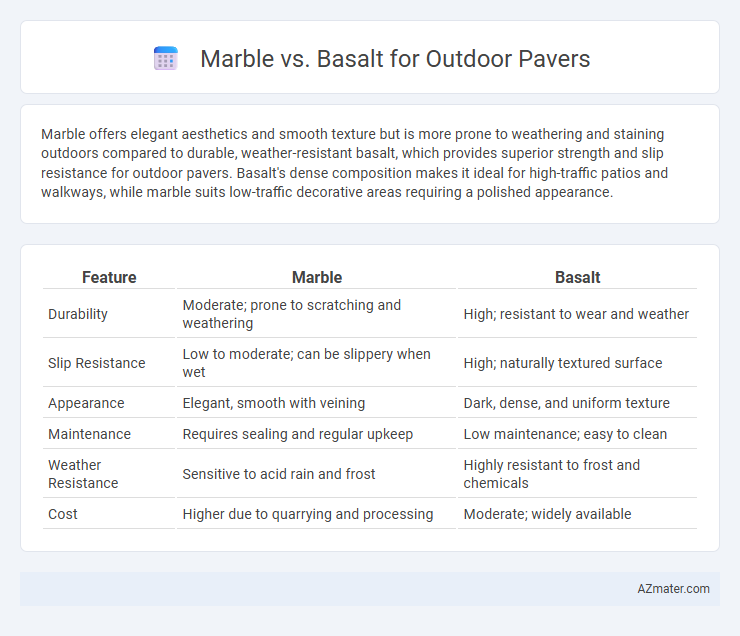Marble offers elegant aesthetics and smooth texture but is more prone to weathering and staining outdoors compared to durable, weather-resistant basalt, which provides superior strength and slip resistance for outdoor pavers. Basalt's dense composition makes it ideal for high-traffic patios and walkways, while marble suits low-traffic decorative areas requiring a polished appearance.
Table of Comparison
| Feature | Marble | Basalt |
|---|---|---|
| Durability | Moderate; prone to scratching and weathering | High; resistant to wear and weather |
| Slip Resistance | Low to moderate; can be slippery when wet | High; naturally textured surface |
| Appearance | Elegant, smooth with veining | Dark, dense, and uniform texture |
| Maintenance | Requires sealing and regular upkeep | Low maintenance; easy to clean |
| Weather Resistance | Sensitive to acid rain and frost | Highly resistant to frost and chemicals |
| Cost | Higher due to quarrying and processing | Moderate; widely available |
Introduction to Marble and Basalt Pavers
Marble pavers are renowned for their elegant appearance and smooth texture, offering timeless beauty and a wide range of color variations ideal for upscale outdoor spaces. Basalt pavers, derived from volcanic rock, provide exceptional durability and slip resistance, making them suitable for high-traffic areas and harsh weather conditions. Both materials offer unique aesthetic and functional benefits, with marble emphasizing luxury and sophistication, while basalt delivers strength and resilience for outdoor paving applications.
Key Differences Between Marble and Basalt
Marble outdoor pavers offer a luxurious, polished appearance with unique veining patterns and a lighter color palette, but they tend to be softer and more porous, making them less resistant to weathering and staining compared to basalt. Basalt pavers are dense, dark-colored volcanic stones renowned for their exceptional durability, slip resistance, and ability to withstand harsh outdoor conditions, making them ideal for high-traffic areas and wet environments. The key differences lie in marble's aesthetic appeal and susceptibility to damage versus basalt's robust strength and low maintenance requirements in outdoor applications.
Aesthetic Appeal: Marble vs Basalt
Marble offers a luxurious and elegant aesthetic with its smooth texture, natural veining, and wide color palette that ranges from bright whites to deep greens, making it a popular choice for sophisticated outdoor pavers. Basalt features a more subdued, uniform appearance with a fine-grained texture and rich dark tones, providing a modern and sleek look ideal for minimalist and contemporary outdoor spaces. The choice between marble and basalt for outdoor pavers often depends on the desired visual impact, with marble delivering high contrast and vibrant patterns, while basalt offers durability combined with understated elegance.
Durability and Strength Comparison
Basalt exhibits superior durability and strength compared to marble, making it a preferred choice for outdoor pavers subjected to heavy foot traffic and harsh weather conditions. Marble is more prone to scratching, chipping, and acid damage, whereas basalt offers high resistance to abrasion and chemical corrosion. The dense, fine-grained structure of basalt ensures long-lasting performance, whereas marble may require more frequent maintenance and sealing to preserve its appearance and integrity.
Weather and Slip Resistance
Basalt offers superior weather resistance compared to marble, maintaining durability under extreme temperatures and heavy rainfall without significant erosion or color fading. Marble, while aesthetically appealing, tends to absorb moisture more readily, which can lead to surface degradation and increased slipperiness when wet. Basalt's naturally textured surface provides excellent slip resistance, making it a safer choice for outdoor pavers in wet or icy conditions.
Maintenance Requirements
Marble outdoor pavers require regular sealing and cleaning to prevent staining and weathering due to their porous nature. Basalt, being dense and non-porous, demands minimal maintenance, resisting mold, mildew, and fading effectively. Choosing basalt reduces long-term upkeep costs, making it a practical option for high-traffic outdoor areas.
Cost Analysis: Marble vs Basalt Pavers
Marble pavers generally have a higher upfront cost than basalt pavers due to marble's intricate quarrying and polishing processes, making it a premium choice for outdoor flooring. Basalt pavers offer a more budget-friendly alternative, with lower material and installation expenses, while delivering exceptional durability and weather resistance. Evaluating long-term maintenance, basalt tends to incur lower upkeep costs compared to marble, which may require periodic sealing and more intensive cleaning to prevent staining and surface damage.
Environmental Impact and Sustainability
Basalt is recognized for its lower environmental impact compared to marble due to its natural abundance and minimal chemical processing, resulting in reduced carbon emissions during extraction and fabrication. Marble mining often involves intensive quarrying with higher energy consumption and generates more waste, contributing to habitat disruption and increased ecological footprint. Choosing basalt for outdoor pavers enhances sustainability by promoting durability and requiring less maintenance, thus reducing the need for frequent replacements and resource use over time.
Best Applications for Each Stone
Marble excels in outdoor paver applications where aesthetic appeal and elegance are prioritized, such as patios, walkways, and decorative garden paths, due to its smooth surface and rich veining. Basalt, with its high durability, slip resistance, and weather-proof qualities, is ideal for high-traffic areas like driveways, pool surrounds, and commercial outdoor spaces exposed to harsh environmental conditions. Choosing between marble and basalt for outdoor pavers depends on balancing visual sophistication with functional toughness tailored to specific landscaping needs.
Conclusion: Choosing the Right Stone for Outdoor Pavers
Marble offers elegant aesthetics with a smooth finish and diverse color options, making it ideal for decorative outdoor pavers in low-traffic areas. Basalt provides superior durability, slip resistance, and weather resilience, suitable for high-traffic zones and harsher climates. Selecting the right stone depends on balancing design preferences with functional needs, where basalt excels in strength and longevity while marble emphasizes style and surface refinement.

Infographic: Marble vs Basalt for Outdoor Paver
 azmater.com
azmater.com